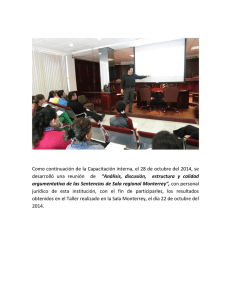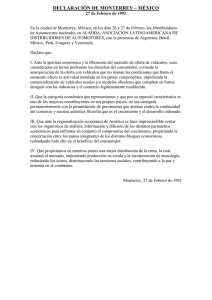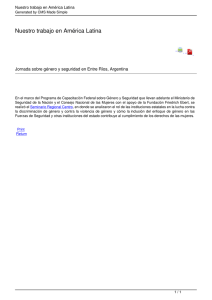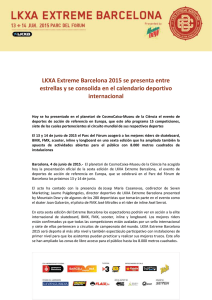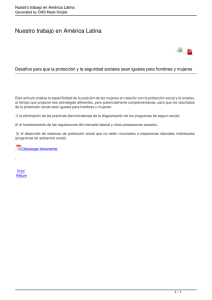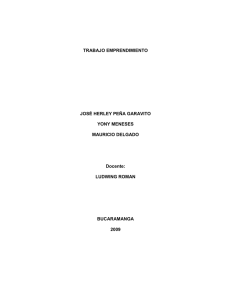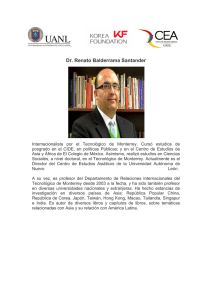Español
Anuncio
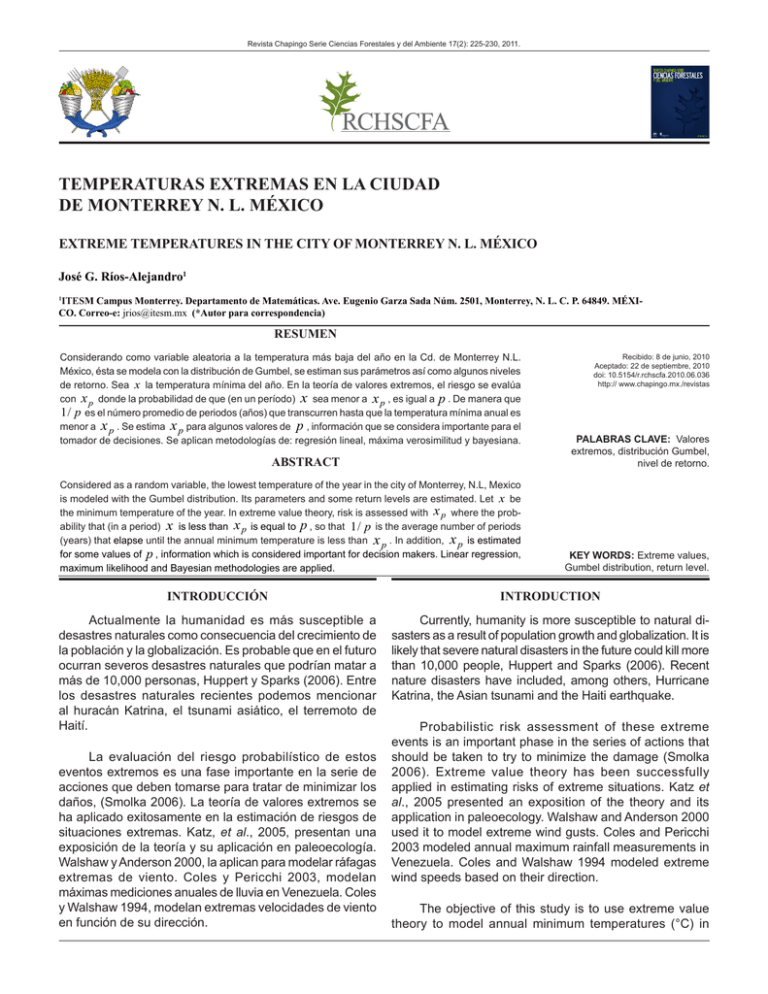
Revista Chapingo Serie Ciencias Forestales y del Ambiente 17(2): 225-230, 2011. TEMPERATURAS EXTREMAS EN LA CIUDAD DE MONTERREY N. L. MÉXICO EXTREME TEMPERATURES IN THE CITY OF MONTERREY N. L. MÉXICO José G. Ríos-Alejandro1 ITESM Campus Monterrey. Departamento de Matemáticas. Ave. Eugenio Garza Sada Núm. 2501, Monterrey, N. L. C. P. 64849. MÉXICO. Correo-e: [email protected] (*Autor para correspondencia) 1 RESUMEN Considerando como variable aleatoria a la temperatura más baja del año en la Cd. de Monterrey N.L. México, ésta se modela con la distribución de Gumbel, se estiman sus parámetros así como algunos niveles de retorno. Sea x la temperatura mínima del año. En la teoría de valores extremos, el riesgo se evalúa con x p donde la probabilidad de que (en un período) x sea menor a x p , es igual a p . De manera que 1 / p es el número promedio de periodos (años) que transcurren hasta que la temperatura mínima anual es menor a x p . Se estima x p para algunos valores de p , información que se considera importante para el tomador de decisiones. Se aplican metodologías de: regresión lineal, máxima verosimilitud y bayesiana. ABSTRACT Considered as a random variable, the lowest temperature of the year in the city of Monterrey, N.L, Mexico is modeled with the Gumbel distribution. Its parameters and some return levels are estimated. Let x be the minimum temperature of the year. In extreme value theory, risk is assessed with x p where the probability that (in a period) x is less than x p is equal to p , so that 1 / p is the average number of periods (years) that elapse until the annual minimum temperature is less than x p . In addition, x p is estimated for some values of p , information which is considered important for decision makers. Linear regression, maximum likelihood and Bayesian methodologies are applied. Recibido: 8 de junio, 2010 Aceptado: 22 de septiembre, 2010 doi: 10.5154/r.rchscfa.2010.06.036 http:// www.chapingo.mx./revistas PALABRAS CLAVE: Valores extremos, distribución Gumbel, nivel de retorno. KEY WORDS: Extreme values, Gumbel distribution, return level. INTRODUCCIÓN INTRODUCTION Actualmente la humanidad es más susceptible a desastres naturales como consecuencia del crecimiento de la población y la globalización. Es probable que en el futuro ocurran severos desastres naturales que podrían matar a más de 10,000 personas, Huppert y Sparks (2006). Entre los desastres naturales recientes podemos mencionar al huracán Katrina, el tsunami asiático, el terremoto de Haití. Currently, humanity is more susceptible to natural disasters as a result of population growth and globalization. It is likely that severe natural disasters in the future could kill more than 10,000 people, Huppert and Sparks (2006). Recent nature disasters have included, among others, Hurricane Katrina, the Asian tsunami and the Haiti earthquake. La evaluación del riesgo probabilístico de estos eventos extremos es una fase importante en la serie de acciones que deben tomarse para tratar de minimizar los daños, (Smolka 2006). La teoría de valores extremos se ha aplicado exitosamente en la estimación de riesgos de situaciones extremas. Katz, et al., 2005, presentan una exposición de la teoría y su aplicación en paleoecología. Walshaw y Anderson 2000, la aplican para modelar ráfagas extremas de viento. Coles y Pericchi 2003, modelan máximas mediciones anuales de lluvia en Venezuela. Coles y Walshaw 1994, modelan extremas velocidades de viento en función de su dirección. Probabilistic risk assessment of these extreme events is an important phase in the series of actions that should be taken to try to minimize the damage (Smolka 2006). Extreme value theory has been successfully applied in estimating risks of extreme situations. Katz et al., 2005 presented an exposition of the theory and its application in paleoecology. Walshaw and Anderson 2000 used it to model extreme wind gusts. Coles and Pericchi 2003 modeled annual maximum rainfall measurements in Venezuela. Coles and Walshaw 1994 modeled extreme wind speeds based on their direction. The objective of this study is to use extreme value theory to model annual minimum temperatures (°C) in 225 Temperaturas extremas... José G. Ríos-Alejandro, et. al. El presente estudio tiene por objetivo aplicar la teoría de valores extremos para modelar las temperaturas mínimas anuales (°C) en la Cd. de Monterrey, y tratar de estimar los riesgos de temperaturas extremas en invierno a través de sus valores y períodos de retorno. Las bajas temperaturas son un factor de riesgo para la población. El estado de Nuevo León, México, invierte recursos en atención a gente por el frío, por ejemplo en 2010 se atendieron 229 personas en albergues por causa del frío, de los cuales el 60 % fueron de la zona metropolitana de la ciudad de Monterrey y murieron tres personas (El Norte, México; 10 de enero 2010, Sección Local:1). Se aplican metodologías de: regresión lineal, máxima verosimilitud y bayesiana. the city of Monterrey, and to try to estimate the risks of extreme winter temperatures through their values and return periods. Low temperatures are a risk factor for the population. The state of Nuevo Leon, Mexico invests resources to care for people affected by the cold. In 2010, for example, 229 people were attended to in shelters because of the cold, of which 60% were from the metropolitan area of Monterrey, and three people died (El Norte, Mexico; January 10, 2010, Local Section:1). Linear regression, maximum likelihood and Bayesian methodologies are applied in this study. MATERIALES Y MÉTODOS The information source was a database of daily temperatures in Monterrey, provided by the Integrated Environmental Monitoring System of the State of Nuevo Leon. The temperature was recorded every hour at four locations around the city, from 1993 to 2009. From each of these 17 years, we selected the lowest temperature of the year (extreme minimum), which are the values shown in Table 1 (Limón1, 2010). Se contó con una base de datos de las temperaturas diarias de Monterrey, facilitada por el Sistema Integral de Monitoreo Ambiental del estado de Nuevo León. La temperatura se registró cada hora en cuatro sitios de la ciudad, desde el año 1993 hasta el año 2009. De cada uno de estos 17 años, se seleccionó la temperatura más baja del año (mínima extrema), que son los valores que se presentan en el Cuadro 1 (Limón1, 2010). Se aplica la metodología de valores extremos (valores máximos por período), pero no se pierde generalidad ya que se pueden modelar los valores mínimos por período (al año) mediante la transformación . Se evaluó el ajuste de los datos a la distribución Gumbel cuya función de distribución acumulada es, con Se estimaron sus parámetros (vía máxima verosimilitud y regresión lineal) así como sus intervalos de confianza (Coles 2001; Casella y Berger 2002). Se estimó el nivel de retorno como una evaluación del riesgo de temperaturas extremas. El nivel de retorno MATERIALS AND METHODS The methodology of extreme values (maximum values per period) was applied, but it did not lose generality since the minimum values can be modeled per period (year) by the transformation . We assessed the extent to which the data fit the Gumbel distribution, whose cumulative distribution function is, with Parameters (via maximum likelihood and linear regression) and confidence intervals were estimated (Coles 2001; Casella and Berger 2002). Return level was estimated as a risk assessment of extreme temperatures. The return level x p is defined as the value of x such that, x p se define como el valor de x tal que, con 0 < p < 1 . No es difícil probar que para la distribución Gumbel Es decir, la probabilidad de que el valor de x p sea excedido en un período es p , o bien, se espera que el valor de x p sea excedido en promedio una vez cada 1 / p períodos (a 1 / p se le llama período de retorno), (Coles 2001). Se obtienen intervalos de confianza para x p mediante el método delta. with 0 < p < 1 1. It is not difficult to prove that for the Gumbel distribution . That is, the probability that the value of x p is exceeded in a period is p , or it is expected that the value of x p is exceeded on average once every 1 / p periods ( 1 / p is called return period), (Coles 2001). Confidence intervals are obtained for x p using the delta method. We also applied Bayesian inference, where through Markov chain Monte Carlo (MCMC) methods 1000 simulated values are generated of posterior distributions 226 Revista Chapingo Serie Ciencias Forestales y del Ambiente 17(2): 225-230, 2011. CUADRO 1. Registro de temperaturas mínimas (extremas) anuales. TABLE 1. Record of annual minimum temperatures (extremes). año 1993 1994 1995 1996 1997 1998 1999 2000 2001 2002 2003 2004 2005 2006 2007 2008 2009 Temp. mínima 1.70 1.45 2.75 -3.60 -l.70 0.25 -0.10 2.00 0.15 -3.15 0.20 -1.95 1.01 1.08 -1.30 -0.72 2.49 M. C. Sonia Limón Hernández 2010. Gobierno del estado de Nuevo León. Subsecretaría de Protección al Medio Ambiente y Recursos Naturales. Análisis de Datos del Sistema Integral de Monitoreo Ambiental. Comunicación privada. M. C. Sonia Limón Hernández 2010. State government of Nuevo Leon.����������������������������������������������������������� ���������������������������������������������������������� Undersecretary of Environmental Protection and Natural Resources. Data Analysis of the Integrated Environmental Monitoring System. Private communication. 1 1 Se aplica también inferencia bayesiana, donde a través de cadenas de Markov-Montecarlo (CMM) se generan 1000 valores simulados de las distribuciones a posteriori y , se corrió de manera independiente una CMM para µ y otra para . Se consideró como distribución a priori a la distribución normal(0, 1), para ambos µ y . Como regla de probabilidad se utilizó la distribución normal (0,0.42) y para se utilizó la distribución normal(0,0.012) donde Gilks et al 1996). , (Coles 2001, Autocorrelation Function for -(temp mínima) (with 5% significance limits for the autocorrelations) 1.0 0.8 Autocorrelation 0.6 0.4 0.2 0.0 -0.2 -0.4 -0.6 -0.8 -1.0 1 2 3 4 5 6 7 8 9 10 Lag RESULTADOS Y DISCUSIÓN FIGURA 1. Función de autocorrelación del negativo de las temperaturas mínimas. FIGURE 1. Negative autocorrelation function for minimum temperatures. La Figura 1 muestra la función de autocorrelación de los datos (-temperatura mínima), de la cual se infiere que las temperaturas mínimas anuales son independientes. Usando el paquete Minitab (Minitab 15) se obtuvo la estimación de máxima verosimilitud de los parámetros de la distribución Gumbel donde, y que se exhibe en la Figura 2, de donde se infiere que los datos se ajustan a la distribución Gumbel. and . A MCMC was run independently for μ and another for . Distribution was considered a priori to the normal distribution (0, 1), for both μ and . As a rule of probability , the normal distribution (0,0.42) was used; for , the normal distribution (0,0.012) was used, where , (Coles 2001, Gilks et al. 1996). RESULTS AND DISCUSSION Probability Plot of -(temp mínima) Largest Extreme Value - 95% CI Loc Scale N AD P-Value 98 97 95 Figure 1 shows the autocorrelation function for the data (-minimum temperature), which indicates that the annual minimum temperatures are independent. Using Minitab statistical software (Minitab 15), the maximum likelihood estimation was obtained for the Gumbel distribution parameters, where and , as shown in Figure 2, from which it can be inferred that the data fit the Gumbel distribution. -0.9142 1.509 17 0.156 >0.250 Percent 90 80 70 60 50 40 30 20 10 1 -5.0 -2.5 0.0 2.5 5.0 -(temp mínima) 7.5 10.0 FIGURA 2. Prueba de ajuste y estimación de máxima verosimilitud. FIGURE 2. Goodness of fit and maximum likelihood estimation. Una primera estimación de estos parámetros por intervalo de confianza es mediante un ajuste de regresión lineal para donde x , tal que para (i ) se estima p con la ecuación . Las estimaciones puntuales son Los intervalos de confianza del 95% son el Cuadro 2 muestra estos resultados ajustando una regresión lineal en Excel. Se estimaron los niveles de retorno y A first confidence interval estimate of these parameters is obtained by linear regression fitting for where , such that for x(i ) , p is estimated with the equation . The point estimates are The 95 % confidence intervals are Table 2 shows these results by fitting a linear regression in Excel. Return levels and their 95 % prediction interval were estimated, with the results shown in Table 3. For example, for p = 0.4 it is estimated that x0.4 = 0.1168, hence the temperature is -0.1168 (return level), which can be interpreted by saying that a year has a 0.4 probability of 227 Temperaturas extremas... José G. Ríos-Alejandro, et. al. CUADRO 2. Resultados del ajuste de una regresión lineal simple. TABLE 2. Results of fitting a simple linear regression. Coefficients Standard Error T Stat P-value Lower 95 % Upper 95 % Intercept -0.886789637 0.080296398 -11.0439529 1.333E-08 -1.05793736 -0.71564192 -LN(-LN(1-p)) 1.494037322 0.060529542 24.6827791 1.468E-13 1.365021657 1.623052987 temperatura LI (95 % conf) LS (95 % conf) CUADRO 3. Estimación de algunos niveles de retorno con regresión lineal TABLE 3. Estimation of some return levels with linear regression. ( R 2 = 0.989 ). p años(1/p) 0.5 2 error estándar -0.3392 0.0737 0.3392 -0.3193 0.9977 0.4 2.5 0.1168 0.0731 -0.1168 -0.7750 0.5414 0.3 3.333 0.6535 0.781 -0.6535 -1.3143 0.0074 0.2 5 1.3542 0.0923 -1.3542 -2.0233 -0.6851 0.1 10 2.4753 0.1255 -2.4753 -3.1685 -1.7822 0.05 20 3.5508 0.1630 -3.5508 -4.2785 -2.8230 0.01 100 5.9860 0.2551 -5.9860 -6.8254 -5.1466 0.002 500 8.3966 0.3498 -8.3966 -9.3788 -7.4143 0.001 1,000 9.4329 0.3910 -9.4329 -10.4833 -8.3825 su intervalo de predicción del 95 %, los resultados se presentan en al Cuadro 3. Por ejemplo, para p = 0.4 se estima que x0.4 = 0.1168 , luego la temperatura es -0.1168 (nivel de retorno), lo cual se puede interpretar diciendo que en un año se tiene una probabilidad de 0.4 que la temperatura mínima sea menor a -0.1168 °C. También se puede decir que en el largo plazo, en promedio cada 1/0.4 = 2.5 años (período de retorno) la temperatura mínima será menor a -0.1168 °C. Por ejemplo, se estima que , luego en un año se tiene una probabilidad de 5 % de que la temperatura mínima sea menor a -3.55 °C con un período de retorno de 20 años. Las últimas dos columnas son los extremos de los intervalos de predicción del 95 % para los niveles de retorno. De manera similar se interpreta el resto de los resultados. having a minimum temperature of less than -0.1168 °C. For example, it is estimated that x0.05 = 3.55, hence a year has a 5 % probability of having a minimum temperature of less than -3.55 °C with a 20-year return period. The last two columns represent the extremes of the 95 % prediction intervals for the return levels. The rest of the results can be similarly interpreted. Aplicando la aproximación normal del estimador de máxima verosimilitud se tiene que la matriz estimada de covarianzas de ( ) es, where the standard errors are, ee( ) and de donde los errores estándar son, ee( ) y ee( ) de confianza del 95% quedan, . , luego, los intervalos y Applying the normal approximation of the maximum likelihood estimator, the estimated covariance matrix of is, ee( ) 95% confidence intervals are, . , hence, the and By applying the delta method, the 95 % confidence intervals are obtained for return levels x p. Table 4 shows the results, which can be interpreted in the same way as the results in Table 3. In Bayesian inference, by averaging the one thousand simulated values of , their point estimates 228 Revista Chapingo Serie Ciencias Forestales y del Ambiente 17(2): 225-230, 2011. CUADRO 4. Intervalos de confianza de algunos niveles de retorno con el método delta. TABLE 4. Confidence intervals for some return levels using the delta method p años 1/p error estándar temperatura LI (95 % conf) LS (95 % conf) 0.5 2.0000 -0.361125 0.464643749 0.3611 -0.5496 1.2718 0.4 2.5000 0.099469 0.539529085 -0.0995 -1.1569 0.9580 0.3 3.3333 0.641537 0.640843455 -0.6415 -1.8976 0.6145 0.2 5.0000 1.349313 0.785764932 -1.3493 -2.8894 0.1908 0.1 10.0000 2.481772 1.033165465 -2.4818 -4.5068 -0.4568 0.05 20.0000 3.568054 1.279433102 -3.5681 -6.0757 -1.0604 0.01 100.0000 6.027794 1.850801322 -6.0278 -9.6554 -2.4002 0.002 500.0000 8.462641 2.424370239 -9.5094 -13.2144 -3.7109 0.001 1000.0000 9.509415 2.672120902 -8.4626 -14.7468 -4.2721 CUADRO 5. Estimación bayesiana de los niveles de retorno. TABLE 5. Bayesian estimation of return levels. p años (1/p) 0.5 0.4 0.3 0.2 0.1 0.05 0.01 0.002 0.001 2 2.5 3.33 5 10 20 100 500 1000 0.5822 0.1227 -0.4181 -1.1242 -2.2540 -3.3376 -5.7915 -8.2205 -9.2648 LS (95 %) 1.7139 1.2772 0.7952 0.1423 -0.8203 -1.6822 -3.6896 -5.5952 -6.3811 LI (95 %) -0.2941 -0.8219 -1.4436 -2.2645 -3.5897 -4.8633 -7.7898 -10.7246 -11.8860 Aplicando el método delta se obtienen los intervalos de confianza del 95% para los niveles de retorno x p . El Cuadro 4 muestra los resultados, se interpreta igual que los resultados del Cuadro 3. De la inferencia bayesiana, promediando los mil valores simulados de se obtienen sus estimaciones puntuales obteniendo, . Mediante percentiles se obtienen los intervalos de credibilidad del 95 % quedando, De los mil pares simulados ( ), se obtuvieron 1,000 valores simulados de niveles de retorno x p . Su promedio es la estimación puntual x̂ p y mediante percentiles se obtuvieron intervalos de credibilidad del 95 %, los resultados se presentan en el Cuadro 5. El segundo renglón “años”, es el período de retorno 1 / p , el tercer renglón es la estimación puntual del nivel de retorno y los dos últimos renglones son los límites del intervalo de credibilidad del 95 % para x p . Tratando de colaborar en la estimación de riesgos de temperaturas mínimas extremas en la Cd. de Monterrey, se aplicó la teoría estadística de los valores extremos, encontrando un buen ajuste de los datos (temperatura mínima anual) a la distribución Gumbel. El riesgo se estimó a través de los niveles de retorno. Se trabajó con: ajuste de regresión lineal simple a los datos, máxima verosimilitud, método delta e inferencia bayesiana. are obtained, being . Through percentiles, the 95 % credible intervals are obtained, being From the thousand simulated pairs ( ), 1,000 simulated values were obtained for return levels x p . The average is the point estimate x̂ p and through percentiles the 95 % credible intervals were obtained. The results are shown in Table 5. The second row titled “años” (years in English) is the return period 1 / p, the third row is the point estimation for the return level and the last two rows are the 95 % credible interval limits for x p . In order to contribute to estimating the risks of extreme minimum temperatures in the city of Monterrey, we applied the statistical theory of extreme values, finding a good fit of the data (annual minimum temperature) to the Gumbel distribution. Risk was estimated through return levels. Methodologies used were: fitting simple linear regression to the data, maximum likelihood, the delta method and Bayesian inference. The best accuracy in relation to the intervals for was obtained with the simple linear regression method, due to the excellent fit (R2 =98.9 %). The best accuracy in the return level intervals was also obtained with the simple linear regression method. In general, the worst estimating accuracy was with the maximum likelihood method, due to the small sample (17 data). 229 Temperaturas extremas... José G. Ríos-Alejandro, et. al. La mejor precisión en los intervalos para se obtuvo con el método de la regresión lineal simple, la razón es el excelente ajuste ( R 2 = 98.9 % ). También la mejor precisión en los intervalos de los niveles de retorno se obtuvo con el método de regresión lineal simple. En general, la peor precisión en la estimación lo tuvo el método de máxima verosimilitud, la explicación de ello es la muestra pequeña (17 datos). Se infiere que prácticamente 40 % es la probabilidad de tener una temperatura mínima anual por debajo de cero °C, razón por la cual cada año se debe tener recursos para auxiliar a la población en este aspecto. En fenómenos extremadamente raros, se estima una probabilidad de 1 % de que la temperatura mínima anual sea por debajo de 6 °C bajo cero, es decir, se estima que ocurre en promedio cada 100 años. Therefore, there is an almost 40% probability of having an annual minimum temperature below zero °C, which is why each year resources are needed to assist the public in this regard. In extremely rare phenomena, there is an estimated 1 % probability that the annual minimum temperature will be 6 degrees below Celsius; i.e., it is estimated to occur on average every 100 years. CONCLUSIONS Based on the available information, it can be inferred that annual minimum temperatures in the city of Monterrey, N. L., Mexico are independent and fit the Gumbel distribution well. Some return levels and periods are estimated with the intent of contributing to the measurement of climate risks. Linear regression, maximum likelihood and Bayesian methodologies are applied. Overall, the best accuracy was achieved with the linear regression method. CONCLUSIONES Con la información disponible, se infiere que las temperaturas mínimas anuales en la ciudad de Monterrey, N. L., México son independientes y se ajustan bien a la distribución Gumbel. Se estiman algunos niveles y periodos de retorno tratando con ello de contribuir a la medición de riesgos climatológicos. Se aplicaron los métodos de: regresión lineal, máxima verosimilitud y bayesiano. En general, la mejor precisión se logró con el método de regresión lineal. LITERATURA CITADA CASELLA G.; BERGER R. L. 2002. Statistical inference second edition. Duxbury. Capítulos 5, 7 y 9. COLES S. 2001. An introduction to statistical modeling of extreme values. Springer-Verlag. pp 18-72 y 169-177. COLES S.; PERICCHI L. 2003. Anticipating catastrophes through extreme value modelling. Journal of the royal statistical society series C. 52:(4) 405-416. DOI: 10.1111/1467-9876.00413 COLES S. G.; WALSHAW D. 1994. Directional modelling of extreme wind speeds. Journal of the royal statistical society series C. 43:(1) 139-157. GILKS W. R.; RICHARDSON S.; SPIEGELHALTER D. J. 1996. Introducing Markov chain Monte Carlo. En GILKS W. R.; End of English Version RICHARDSON S.; SPIEGELHALTER D. J. (editores) Markov chain monte carlo in practice. Chapman & Hall. pp 1-16. HUPPERT, H. E.; SPARKS R. S. 2006. Extreme natural hazards, population growth, globalization and environmental change. Phil. Trans. R. Soc. A. 364:(1845) 1875-1888. DOI: 10.1098/rsta.2006.1803 KATZ R. W.; BRUSH G. S.; PARLANGE M. B. 2005. Statistics of extremes: modeling ecological disturbances. Ecology, 86:(5) 1224-1134. Minitab 15. Minitab® Statistical Software (versión 15). “MINITAB® and all other trademarks and logos for the Company’s products and services are the exclusive property of Minitab Inc. All other marks referenced remain the property of their respective owners. See minitab.com for more information”. SMOLKA A. 2006. Natural disasters and the challenge of extreme events. Phil. Trans. R. Soc. A. 364:(1845) 2147-2165. DOI: 10.1098/rsta.2006.1818 WALSHAW D.; ANDERSON C. W. 2000. A model for extreme wind gusts. Journal of the royal statistical society series C. 49:(4) 499-508. 230
